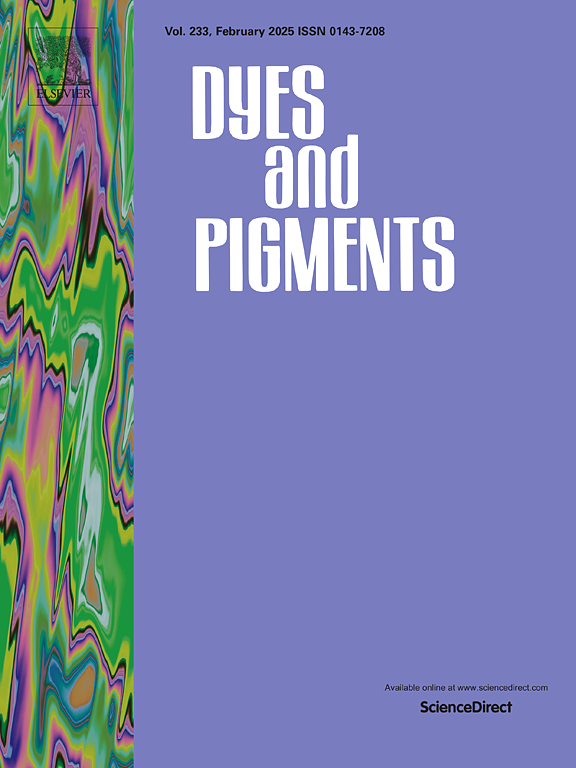Investigation of molecular rotation's influence on twisted ICT states in a series of D-A-A1 organic dyes
IF 4.1
3区 工程技术
Q2 CHEMISTRY, APPLIED
引用次数: 0
Abstract
The Twisted Intramolecular Charge Transfer (TICT) phenomenon can, in some cases, lead to the formation of highly luminescent molecules. Such emitters require donor and acceptor units to be rotationally displaced in the ground state. However, the impact of molecular rotation in the excited state on the photophysical properties of compounds remains insufficiently understood. To bridge this gap, we synthesized and studied a series of donor-acceptor-acceptor (D-A-A1) organic dyes incorporating various chalcogenadiazole acceptors (A) and a cyanoacrylic acid acceptor (A1). Using spectroscopic analysis and TD-DFT calculations, we examined changes in electronic and geometric structures induced by subtle modifications in the acceptor units. Our findings reveal that compounds featuring an additional nitrogen atom in the ortho-position adopt a planar geometry in the first excited singlet state, leading to a blue shift in the emission spectrum while maintaining a high luminescence quantum yield of up to 63 % in cyclohexane. The results demonstrate that a planar excited-state geometry enhances ICT emission efficiency compared to a twisted configuration. Additionally, we identified a distinct solvatochromic behavior in the studied dyes. These insights contribute to a deeper understanding of the TICT mechanism and provide a new strategy for designing highly luminescent organic dyes.
分子旋转对一系列D-A-A1有机染料中扭曲ICT态影响的研究
扭曲的分子内电荷转移(TICT)现象,在某些情况下,可以导致高发光分子的形成。这种发射体要求供体和受体单位在基态下旋转移位。然而,激发态分子旋转对化合物光物理性质的影响仍未得到充分的了解。为了弥补这一空白,我们合成并研究了一系列含有各种硫代二唑受体(a)和氰丙烯酸受体(A1)的供体-受体-受体(D-A-A1)有机染料。利用光谱分析和TD-DFT计算,我们研究了由受体单元的细微修改引起的电子和几何结构的变化。我们的研究结果表明,具有邻位额外氮原子的化合物在第一激发单重态中采用平面几何结构,导致发射光谱中的蓝移,同时在环己烷中保持高达63%的高发光量子产率。结果表明,与扭曲结构相比,平面激发态几何结构提高了ICT发射效率。此外,我们在研究的染料中发现了独特的溶剂化变色行为。这些见解有助于更深入地了解TICT机制,并为设计高发光有机染料提供了新的策略。
本文章由计算机程序翻译,如有差异,请以英文原文为准。
求助全文
约1分钟内获得全文
求助全文
来源期刊

Dyes and Pigments
工程技术-材料科学:纺织
CiteScore
8.20
自引率
13.30%
发文量
933
审稿时长
33 days
期刊介绍:
Dyes and Pigments covers the scientific and technical aspects of the chemistry and physics of dyes, pigments and their intermediates. Emphasis is placed on the properties of the colouring matters themselves rather than on their applications or the system in which they may be applied.
Thus the journal accepts research and review papers on the synthesis of dyes, pigments and intermediates, their physical or chemical properties, e.g. spectroscopic, surface, solution or solid state characteristics, the physical aspects of their preparation, e.g. precipitation, nucleation and growth, crystal formation, liquid crystalline characteristics, their photochemical, ecological or biological properties and the relationship between colour and chemical constitution. However, papers are considered which deal with the more fundamental aspects of colourant application and of the interactions of colourants with substrates or media.
The journal will interest a wide variety of workers in a range of disciplines whose work involves dyes, pigments and their intermediates, and provides a platform for investigators with common interests but diverse fields of activity such as cosmetics, reprographics, dye and pigment synthesis, medical research, polymers, etc.
 求助内容:
求助内容: 应助结果提醒方式:
应助结果提醒方式:


